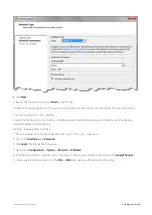
Exinda Network Orchestrator
2 Getting started
|
50
The physical server is a re-purposed Dell Server and has the following physical/logical interface mappings for illus-
tration purposes only (you are encouraged to select your own server):
ESXi Ethernet Ports
NIC0
NIC1
NIC2
Exinda Ethernet Ports
ETH0
ETH1
ETH2
ESXi Virtual Switches
SW0
SW1
SW2
The host has three NICs; NIC 0 is dedicated for management of the system.
NIC 1 is dedicated to all virtual application workloads hosted on the ESXi.
All virtual application workloads are configured in the ESXi to SW1.
The Exinda Virtual Appliance is configured on SW2 virtual switch and is mapped to the NIC2 interface.
The NIC2 interface has a direct connection to the WAN router, and is configured for WCCP GRE layer 3 mode
between the router and the Exinda Virtual Appliance.
VMware version = 5.5 and 6.0
Exinda Virtual Appliance firmware version = 7.4.4
The data path for virtualized applications configured on SW1 takes two paths:
Path one – un-optimized and un-accelerated traffic is forwarded directly to the WAN router through NIC1.
Path two – traffic to be optimized (traffic shaped) and accelerated traffic is forwarded to the router for redir-
ection through WCCP to the Exinda Virtual Appliance through NIC2/SW2 on the AUX port of the Exinda Virtual
Appliance.
(Optional) It is possible to configure and map all data traffic on SW1 and SW2 to the NIC1 interface; however, for per-
formance reasons it is recommended to segment the optimized traffic on its own NIC and virtual switch for per-
formance reasons, and in the event of failure of the Exinda Virtual Appliance.
Out-of-band and High Availability (PBR/VRRP) Mode
In this use case, there are multiple Exinda Virtual Appliances set up for out-of-band mode and configured for High
Availability. PBR is the protocol used for redirection while the appliances act as VRRP nodes. One Exinda acts as the
Master node, receiving all redirected traffic from the WAN router, and all remaining Exinda Virtual Appliances act as
Backup nodes in case the Master fails.
This deployment would be typical for customers who are choosing to redirect a percentage of their traffic for
acceleration and traffic shaping through the Exinda virtual appliances.
To configure PBR/VRRP on the Exinda Virtual Appliance, see
.
This configuration would work in either a branch office with virtual infrastructure, or in a data center where the
application and local user traffic accessing the WAN is redirected to the Exinda virtual appliance for Diagnostics, Shaping,
and Acceleration.
Scenario
Branch users access virtualized, local services (print, DHCP, Active Directory, etc.).
One physical NIC interface is dedicated for management of the virtual machines and hypervisor.
One physical NIC interface is configured on the hypervisor for LAN access, and has a routed connection to the WAN
router.
Summary of Contents for EXNV-10063
Page 369: ...Exinda Network Orchestrator 4 Settings 369 ...
Page 411: ...Exinda Network Orchestrator 4 Settings 411 Screenshot 168 P2P OverflowVirtualCircuit ...
Page 420: ...Exinda Network Orchestrator 4 Settings 420 Screenshot 175 Students OverflowVirtualCircuit ...
















































